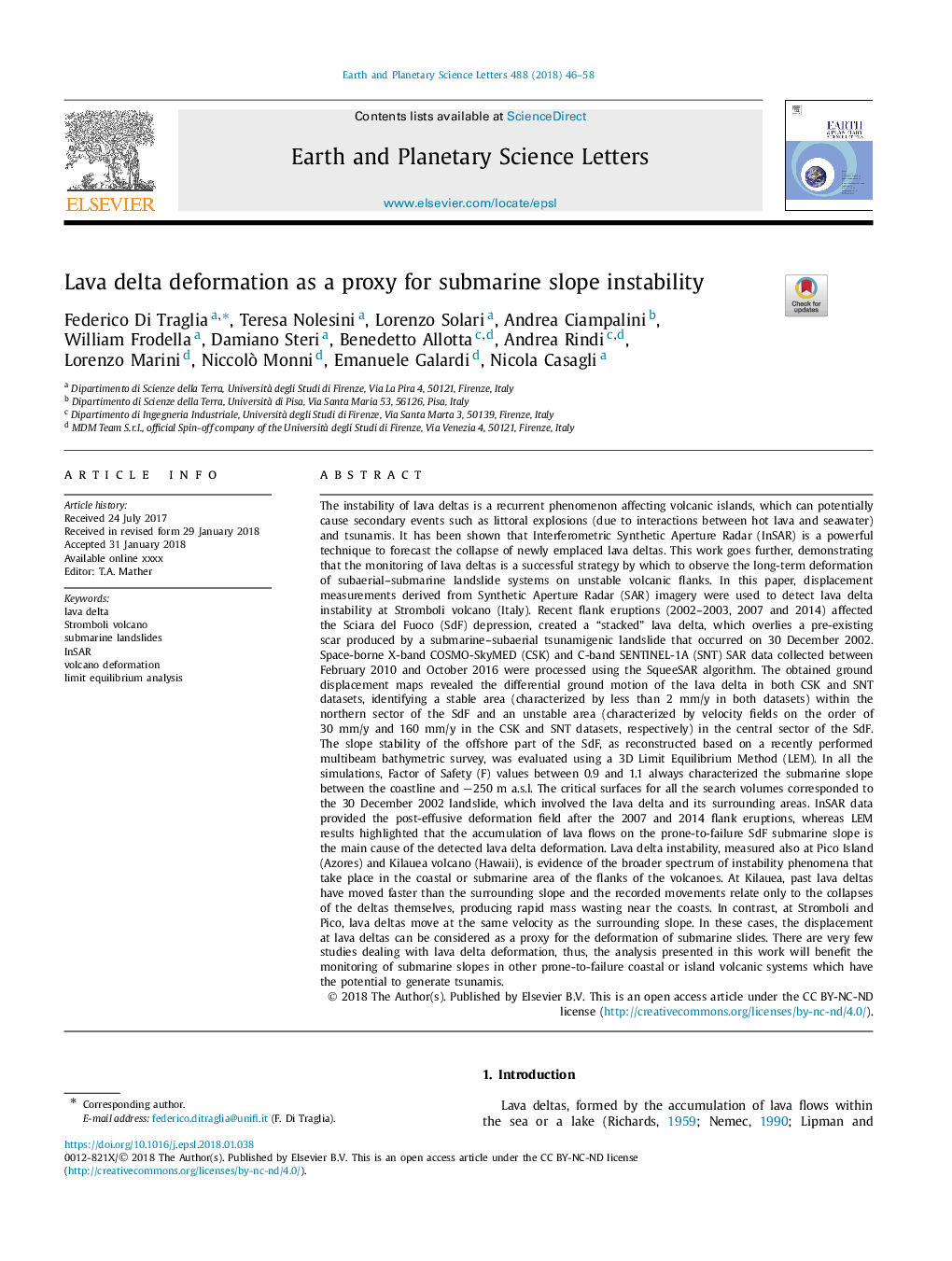| کد مقاله | کد نشریه | سال انتشار | مقاله انگلیسی | نسخه تمام متن |
|---|---|---|---|---|
| 8907041 | 1634668 | 2018 | 13 صفحه PDF | دانلود رایگان |
عنوان انگلیسی مقاله ISI
Lava delta deformation as a proxy for submarine slope instability
ترجمه فارسی عنوان
تغییر شکل دلفی گدازه به عنوان یک پروکسی برای بی ثباتی شیب زیردریایی
دانلود مقاله + سفارش ترجمه
دانلود مقاله ISI انگلیسی
رایگان برای ایرانیان
کلمات کلیدی
موضوعات مرتبط
مهندسی و علوم پایه
علوم زمین و سیارات
علوم زمین و سیاره ای (عمومی)
چکیده انگلیسی
The instability of lava deltas is a recurrent phenomenon affecting volcanic islands, which can potentially cause secondary events such as littoral explosions (due to interactions between hot lava and seawater) and tsunamis. It has been shown that Interferometric Synthetic Aperture Radar (InSAR) is a powerful technique to forecast the collapse of newly emplaced lava deltas. This work goes further, demonstrating that the monitoring of lava deltas is a successful strategy by which to observe the long-term deformation of subaerial-submarine landslide systems on unstable volcanic flanks. In this paper, displacement measurements derived from Synthetic Aperture Radar (SAR) imagery were used to detect lava delta instability at Stromboli volcano (Italy). Recent flank eruptions (2002-2003, 2007 and 2014) affected the Sciara del Fuoco (SdF) depression, created a “stacked” lava delta, which overlies a pre-existing scar produced by a submarine-subaerial tsunamigenic landslide that occurred on 30 December 2002. Space-borne X-band COSMO-SkyMED (CSK) and C-band SENTINEL-1A (SNT) SAR data collected between February 2010 and October 2016 were processed using the SqueeSAR algorithm. The obtained ground displacement maps revealed the differential ground motion of the lava delta in both CSK and SNT datasets, identifying a stable area (characterized by less than 2 mm/y in both datasets) within the northern sector of the SdF and an unstable area (characterized by velocity fields on the order of 30 mm/y and 160 mm/y in the CSK and SNT datasets, respectively) in the central sector of the SdF. The slope stability of the offshore part of the SdF, as reconstructed based on a recently performed multibeam bathymetric survey, was evaluated using a 3D Limit Equilibrium Method (LEM). In all the simulations, Factor of Safety (F) values between 0.9 and 1.1 always characterized the submarine slope between the coastline and â250 m a.s.l. The critical surfaces for all the search volumes corresponded to the 30 December 2002 landslide, which involved the lava delta and its surrounding areas. InSAR data provided the post-effusive deformation field after the 2007 and 2014 flank eruptions, whereas LEM results highlighted that the accumulation of lava flows on the prone-to-failure SdF submarine slope is the main cause of the detected lava delta deformation. Lava delta instability, measured also at Pico Island (Azores) and Kilauea volcano (Hawaii), is evidence of the broader spectrum of instability phenomena that take place in the coastal or submarine area of the flanks of the volcanoes. At Kilauea, past lava deltas have moved faster than the surrounding slope and the recorded movements relate only to the collapses of the deltas themselves, producing rapid mass wasting near the coasts. In contrast, at Stromboli and Pico, lava deltas move at the same velocity as the surrounding slope. In these cases, the displacement at lava deltas can be considered as a proxy for the deformation of submarine slides. There are very few studies dealing with lava delta deformation, thus, the analysis presented in this work will benefit the monitoring of submarine slopes in other prone-to-failure coastal or island volcanic systems which have the potential to generate tsunamis.
ناشر
Database: Elsevier - ScienceDirect (ساینس دایرکت)
Journal: Earth and Planetary Science Letters - Volume 488, 15 April 2018, Pages 46-58
Journal: Earth and Planetary Science Letters - Volume 488, 15 April 2018, Pages 46-58
نویسندگان
Federico Di Traglia, Teresa Nolesini, Lorenzo Solari, Andrea Ciampalini, William Frodella, Damiano Steri, Benedetto Allotta, Andrea Rindi, Lorenzo Marini, Niccolò Monni, Emanuele Galardi, Nicola Casagli,
